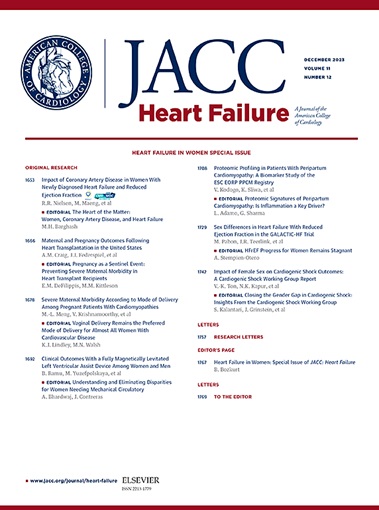Rapid Uptitration of Guideline-Directed Medical Therapies in Acute Heart Failure With and Without Atrial Fibrillation
IF 10.3
1区 医学
Q1 CARDIAC & CARDIOVASCULAR SYSTEMS
引用次数: 0
Abstract
Background
Rapid uptitration of guideline-directed medical therapy (GDMT) before and after discharge in hospitalized heart failure (HF) patients is feasible, is safe, and improves outcomes; whether this is also true in patients with coexistent atrial fibrillation/flutter (AF/AFL) is not known.
Objectives
This study sought to investigate whether rapid GDMT uptitration before and after discharge for HF is feasible, safe and beneficial in patients with and without AF/AFL.
Methods
In this secondary analysis of the STRONG-HF (Safety, Tolerability, and Efficacy of Rapid Optimization, Helped by NT-proBNP Testing, of Heart Failure Therapies) trial, GDMT uptitration and patient outcomes were analyzed by AF/AFL status and type (permanent, persistent, paroxysmal).
Results
Among 1,078 patients enrolled in STRONG-HF, 496 (46%) had a history of AF, including 238 assigned to high-intensity care (HIC) and 258 to usual care (UC), and 581 did not have a history of AF/AFL, including 304 assigned to HIC and 277 to UC. By day 90, the average percent optimal dose of neurohormonal inhibitors achieved in the HIC arm was similar in patients with and without AF/AFL, reaching approximately 80% of the optimal dose (average absolute difference between AF/AFL and non-AF/AFL groups: −0.81%; 95% CI: −3.51 to 1.89). All-cause death or HF readmission by day 180 occurred less frequently in the HIC than the UC arm, both in patients with and without AF (adjusted HR: 0.75 [95% CI: 0.48-1.19] in AF vs adjusted HR: 0.50 [95% CI: 0.31-0.79] in non-AF/AFL patients; P for interaction = 0.2107). Adverse event rates were similar in patients with and without AF/AFL. AF/AFL type did not affect either uptitration or patient outcomes.
Conclusions
Nearly half of acute HF patients have AF/AFL history. Rapid GDMT uptitration before and early after discharge is feasible, is safe, and may improve outcomes regardless of AF presence or type. (Safety, Tolerability, and Efficacy of Rapid Optimization, Helped by NT-proBNP Testing, of Heart Failure Therapies [STRONG-HF]; NCT03412201)
对伴有或不伴有心房颤动的急性心力衰竭患者快速调整指南指导的药物治疗。
背景:住院心力衰竭(HF)患者出院前后快速调整指南指导的药物治疗(GDMT)是可行的、安全的,并能改善预后;但对于合并心房颤动/扑动(AF/AFL)的患者是否也是如此,目前尚不清楚:本研究旨在探讨房颤/扑动患者和非房颤/扑动患者出院前后快速升高 GDMT 是否可行、安全和有益:在这项 STRONG-HF(在 NT-proBNP 检测的帮助下快速优化心衰治疗的安全性、耐受性和有效性)试验的二次分析中,根据房颤/房颤状态和类型(永久性、持续性、阵发性)对 GDMT 升压和患者预后进行了分析:在加入 STRONG-HF 的 1,078 名患者中,496 人(46%)有房颤病史,其中 238 人被分配到高强度护理 (HIC) 中,258 人被分配到常规护理 (UC);581 人没有房颤/AFL 病史,其中 304 人被分配到高强度护理 (HIC) 中,277 人被分配到常规护理 (UC)。到第 90 天时,有房颤/有心房颤动和无房颤/无心房颤动患者在 HIC 治疗组中获得的神经激素抑制剂平均最佳剂量百分比相似,都达到了最佳剂量的 80% 左右(有房颤/有心房颤动组和无房颤/无心房颤动组之间的平均绝对差异:-0.81%;95% CI:-3.51 至 1.89)。在心房颤动和非心房颤动患者中,HIC 组比 UC 组更少发生第 180 天的全因死亡或 HF 再入院(心房颤动患者的调整 HR:0.75 [95% CI:0.48-1.19];非心房颤动/心房颤动患者的调整 HR:0.50 [95% CI:0.31-0.79];交互作用 P = 0.2107)。房颤/AFL患者和非房颤/AFL患者的不良事件发生率相似。AF/AFL类型对升压或患者预后均无影响:结论:近一半的急性心房颤动患者有房颤/AFL病史。结论:近一半的急性心力衰竭患者有房颤/房颤史,在出院前和出院后早期快速应用 GDMT 是可行的、安全的,而且无论房颤存在与否或房颤类型如何,都能改善预后。(由 NT-proBNP 检测帮助快速优化心衰疗法的安全性、耐受性和有效性[STRONG-HF];NCT03412201)。
本文章由计算机程序翻译,如有差异,请以英文原文为准。
求助全文
约1分钟内获得全文
求助全文
来源期刊

JACC. Heart failure
CARDIAC & CARDIOVASCULAR SYSTEMS-
CiteScore
21.20
自引率
2.30%
发文量
164
期刊介绍:
JACC: Heart Failure publishes crucial findings on the pathophysiology, diagnosis, treatment, and care of heart failure patients. The goal is to enhance understanding through timely scientific communication on disease, clinical trials, outcomes, and therapeutic advances. The Journal fosters interdisciplinary connections with neuroscience, pulmonary medicine, nephrology, electrophysiology, and surgery related to heart failure. It also covers articles on pharmacogenetics, biomarkers, and metabolomics.
 求助内容:
求助内容: 应助结果提醒方式:
应助结果提醒方式:


